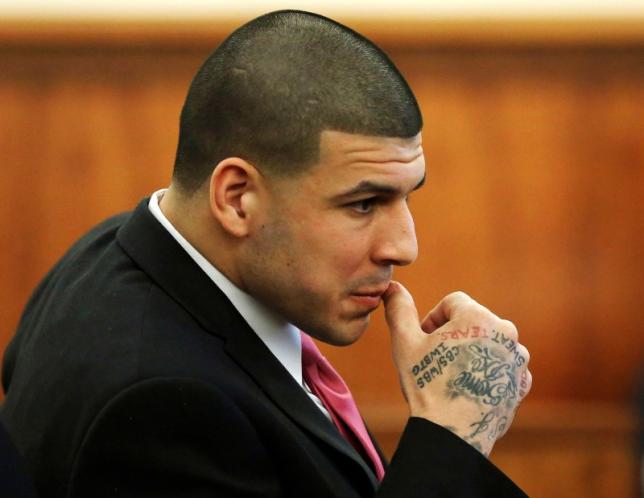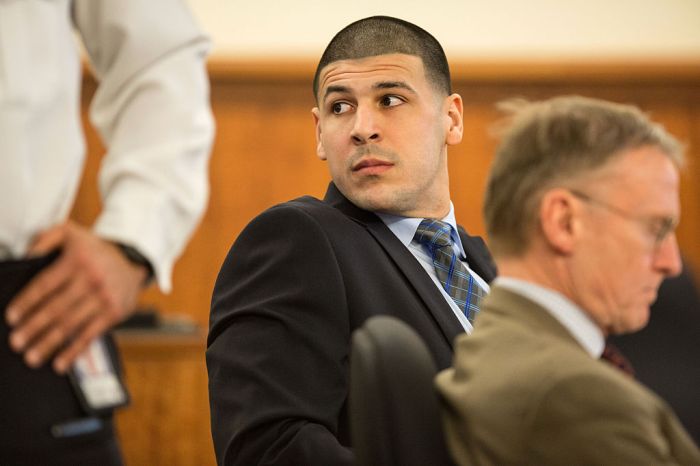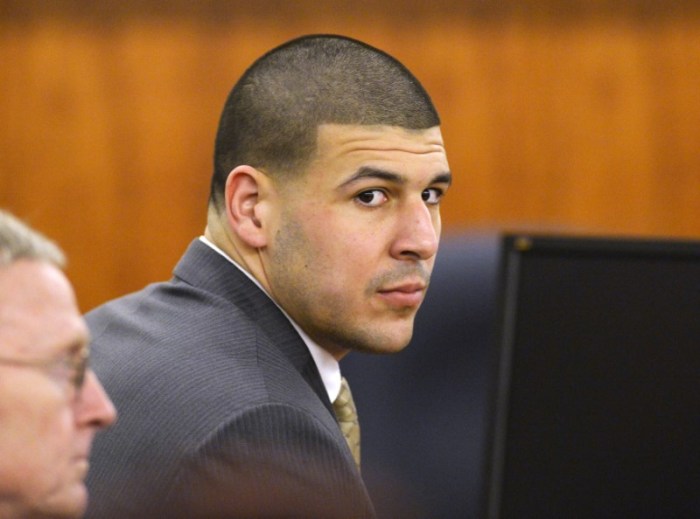After Aaron Hernandez was found hanging by a bed sheet in his cell early Wednesday morning, the timing of his apparent suicide has left some scratching their heads.
The former Patriots tight end was just acquitted Friday of the double murder of Safiro Furtado and Daniel de Abreu, and his lawyer was optimistic about an appeal on his conviction of the 2013 murder of Odin Lloyd, for which Hernandez was sentenced to life behind bars.
“Aaron was looking forward to an opportunity for a second chance to prove his innocence,” lawyer Jose Baez said in a statement to WCVB. Hernandez’s agent echoed his lawyer’s remarks.
“Absolutely no chance he took his own life,” Brian Murphy, president of Athletes First, the firm that represented Hernandez during his NFL career, tweeted.
His family and lawyers are calling for an independent investigation.
So why did he do it? Several possibilities abound, not least of which is the fact that the 27-year-old was facing life in prison without the possibility of parole for the 2013 killing. But there are potential reasons:
The money
Hernandez was a star player in his day, signing a $40 million contract with the New England Patriots in 2012.
Due to his arrest for the 2013 murder of Odin Lloyd, Hernandez would never get to finish out the terms of that contract, but it’s likely Hernandez saw in the ballpark of $20 million before his time playing was up.
His fast life and two expensive — and very public — murder trials, however, likely ate up most of his assets, as evidenced by the fact that Hernandez had a state-appointed attorney by the end of his second trial.
“Who knows if he had anything left at all,” David White, former president of the Massachusetts Bar Association said. “The fact that he has a court-appointed lawyer for appeal tells you he didn’t have a lot of money in the bank.”
What his death could have done is preserve whatever little assets Hernandez had left, White said.
Since Hernandez died before his appeals could be exhausted in accordance with Massachusetts law, his conviction of Lloyd’s murder will be voided. This could mean he is owed money by the NFL and the Patriots via his contract and pension, USA Today reported.
The families of Lloyd, Furtado and Abreu have indicated interest in going after Hernandez assets in civil court, but White said there might not be much there to take.
“Pensions [are] not reachable assets, so they are not able to collect against that,” White said.
“Another question that I don’t think anybody knows the answer to is whether he had life insurance,” White said. Despite his death by suicide, White said if his policy is older than a year or two, his beneficiary could still collect and that money would also be protected from a civil suit by victim’s families.
Traumatic brain injury
Speculation as to whether Hernandez suffered from chronic traumatic encephalopathy — called CTE — has long followed the 27-year-old convicted murderer.
The degenerative neurological condition caused by repeated head trauma triggers massive changes in the personalities of those it afflicts — leading to depression, addiction and violent behavior.
The NFL has been hammered by the condition in recent years. Initially, the league tried to deny a link between concussions and CTE, but in 2015 it lost a massive lawsuit brought by more than 5,000 ex-NFL players, which accused the league of hiding the dangers of concussions and the repeated head injuries that are often sustained by players.
“I think over 90 percent … of players who play to the professional level have some degree of this disease. I have not examined any brain of a retired football player that came back negative,” Bennet Omalu, the Nigeria-born neuropathologist who first discovered the condition told Time.
Hernandez is far from the first ex-NFL player to be swept up in violence. Rosters of former NFL stars now resemble a tragic CTE roll call.
Former Atlanta Falcons safety Ray Easterling and Junior Seau of the San Diego Charges both committed suicide in 2012.
Chicago Bears safety Dave Duerson shot himself in 2011.
Jovan Belcher, a player for the Kansas City Chiefs, killed his girlfriend then drove to the Chiefs’ training facility before he turned the gun on himself, committing suicide in front of the team’s general manager.
All were discovered, after their deaths, to have suffered from CTE.
The disease is not saved for aging players, however. The 2013 death of Michael Keck, a former high school starter who never played pro ball, showed the condition could afflict much younger players. Keck was only 25 when he died.
Hernandez was a lifelong football player, but he was also known to get into tangles with police from a young age. Only an autopsy can tell whether CTE played a role in Hernandez’s aggressive behavior.
Homosexuality rumors
This was a question posed just days before the former Patriots tight end’s death on Boston-based sports radio station WEEI.
Boston journalist Michele McPhee was a guest on WEEI’s “Kirk and Callahan” show Monday to discuss her book about the 2013 Boston Marathon bombings, “Maximum Harm.”
Host Gerry Callahan suggest McPhee knew “the real motive for the Odin Lloyd murder.”
“Let’s just say that Odin Lloyd caught Aaron Hernandez in a compromising position,” Callahan said on air, suggesting Hernandez was caught with another man.
McPhee suggested Lloyd died when he made the “unfortunate move to say that out loud to somebody.”
Following news of Hernandez death Wednesday, Callahan and co-host Kirk Minihane doubled down on their assessment that Hernandez’s closeted homosexuality was the reason for Lloyd’s death and said it could have been the reason for his suicide.
A caller to the station who goes by the alias “Rabbit” and has been a source to Minihane and Callahan on the Hernandez front, said it was a “problem” for Hernandez.
“As a gang member, the one thing they don’t take lightly is homosexuality. It’s not allowed,” he said on air. “You have to be terminated. He knew it was going to be nonstop trouble for him.”

























